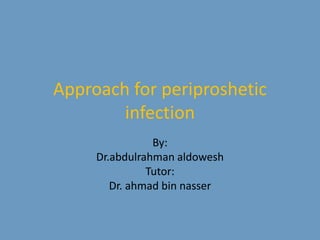
Approach For Periproshetic Infection.pptx
- 1. Approach for periproshetic infection By: Dr.abdulrahman aldowesh Tutor: Dr. ahmad bin nasser
- 2. I. Epidemiology and Overview • Prevalence • The risk of periprosthetic infection following primary knee arthroplasty (1% to 2%) is slightly higher than that following hip arthroplasty (0.3% to 1.3%). • The risk of infection is higher after revision procedures: 3% for hips and 6% for knees.
- 3. 1.Risk factors 1.Postoperative surgical site infection or hematoma formation 2.Wound healing complications 3.Malignant disease 4.Prior joint arthroplasty 5.Prior surgery or infection of the joint or adjacent bone 6.Perioperative nonarticular infection 7.Rheumatoid arthritis 8.Psoriasis 9.Diabetes
- 4. • Prophylaxis • —Administration of antibiotics within 60 minutes before surgery is the most effective method for prevention of periprosthetic infection.
- 5. II. Presentation and Etiology Type of Infection Etiology Time of Onset Signs and Symptoms Acute postoperative infection Frequently caused by Staphylococcus aureus, B- hemolytic Stretptococcus, and sometimes by gram-negative bacteria Symptoms appear within days to weeks Acute onset of joint pain and swelling together with erythema, warmth, tenderness, and possible wound discharge Sinus tract extending to the joint is a definitive sign of infection Late chronic infection Frequently caused by less- virulent organisms: coagulase- negative Staphylococcus and Propionibacterium acnes Occurs several months to 2 years after prosthesis implantation Subtle signs and symptoms, if any Chronic pain and implant loosening are common Difficult to differentiate from mechanical aseptic loosening, but pain associated with chronic infection worsens with time and is accompanied by deterioration in function. Hematogenous seeding Inciting events: skin infection, dental extraction, respiratory tract infection, urinary tract infection Within days after inciting event Sudden onset of pain
- 6. III. Diagnosis A-History and physical examination – A detailed history and physical examination can diagnose periprosthetic infection with reasonable certainty; laboratory tests simply confirm the diagnosis. – Many times, signs and symptoms of periprosthetic infection overlap those of hematoma formation, aseptic loosening, and instability; thus, additional diagnostic tests are often required
- 7. B- imaging studies: 1- x-ray signs: 1.- Periosteal reaction. 2.Scattered foci of osteolysis . 3.Generalized bone resorption in absence of implant wear.
- 10. C-blood tests • Erythrocyte sedimentation rate (ESR) and C- reactive protein (CRP) are nonspecific markers. • Combined, ESR and CRP have a sensitivity of 99% and a specificity of 89%. • Continued elevation of levels of CRP and ESR is concerning for infection. • Interleukin-6 may be useful for diagnosis and for monitoring the progress of infection
- 11. D-Joint aspiration • Joint aspiration is performed when there is a strong suspicion of infection. • Aspiration has a sensitivity of 57% to 93% and a specificity of 88% to 100%. Sensitivity can be improved by repeat aspiration.
- 12. Type Presentation Definition Treatment I Acute postoperative infection Acute infection within first month Attempt at débridement and prosthetic retention II Late chronic infection Chronic indolent infection presenting >1 month after surgery Prosthetic removal III Acute hematogenous infection Acute onset of symptoms in a previously well- functioning joint Attempt at débridement and prosthetic retention, or prosthetic removal IV Positive intraoperative cultures Two or more positive intraoperative cultures Appropriate antibiotics Classification of Periprosthetic Joint Infections
- 13. -Treatment options 1.Surgical 1.Débridement with retention of prosthesis 2.Resection arthroplasty with reimplantation 3.Definitive resection arthroplasty with or without arthrodesis 4.Amputation 2.Nonsurgical—Suppressive antimicrobial therapy
- 14. 1.Two-stage replacement arthroplasty—Two- stage resection and replacement arthroplasty is the gold standard for treatment of infection beyond 4 weeks. 1.Procedure 1.Removal of prosthesis 2.Surgical débridement of the joint 3.Administration of antimicrobials with subsequent delayed reimplantation
- 15. • The time interval between the two surgical procedures is highly variable. • No specific protocol is in place, but early reimplantation has less success. • In infected total knee arthroplasty, reimplantation within 2 weeks has a success rate of approximately 35% compared to success rates of 70% to 90% with delayed reimplantation (>6 weeks) and more extensive antimicrobial therapy. • The proper timing of reimplantation after parenteral antibiotic therapy should be based on the clinical appearance of the wound and improvement in serologic markers of infection, such as the CRP level and the ESR.
- 16. 2.One-stage replacement arthroplasty 1.Procedure 1.All prosthetic components, infected bone, and soft tissue are excised. 2.The new prosthesis is implanted during the same surgery. 3.Intravenous antibiotics are administered for a variable period of time after the revision 2.Indications 1.Mainly for managing infected hip prostheses 2.Used more commonly in Europe
- 17. – Advantages • Single procedure • Lower cost • Earlier mobility • Patient convenience – Disadvantage – Risk of reinfection from residual microorganisms
- 18. 3.Débridement with retention of prosthesis 1. Procedure 1. Débridement of infected tissue and exchange of polyethylene insert with large-volume irrigation 2. Prolonged postoperative antibiotic therapy 2. Indications—Considered when infection developed within 4 weeks of surgery or after an inciting event such as dental extraction. 3. Advantages Limited surgery with preservation of prosthesis and bone stock. 4.Disadvantages 1. Risk of leaving infected foreign body in place 2. Failure rate is generally approximately 20%, with occasional reports of success up to 85%, depending on the outcome factors listed above.
- 19. 4.Resection arthroplasty 1. Procedure 1.Definitive removal of all infected components and tissue 2.No subsequent implantation 2. Indications—Currently are limited, but include the following: 1.Poor quality of bone and soft tissue 2.Recurrent infections 3.Infection with multi-drug-resistant organism 4.Medical conditions that preclude major surgery (reimplantation) 5.Failure of multiple previous exchange arthroplasties 6.Also an acceptable alternative in elderly nonambulatory patients
- 21. VI. Nonsurgical Treatment 1.Treatment—Suppressive antimicrobial therapy. 2.Indications—Considered for frail, elderly, and ill patients in whom surgery is not possible or is refused by the patient. 3.Goals 1.Provide symptomatic relief 2.Maintain joint function 3.Prevent systemic spread of infection rather than eradication of infection 4.Outcomes 1.Success rates of only 10% to 25% 2.Complications occur in 8% to 22% of patients.
- 22. •Thank you
